Grasshoppers are fascinating insects that have captivated nature enthusiasts for centuries. With their powerful hind legs, colorful wings, and unique behaviors, these creatures play an essential role in ecosystems around the globe. In this guide, we explore 35 types of grasshoppers, providing detailed descriptions to help you identify them, understand their habits, and appreciate their ecological importance. Whether you’re an amateur naturalist, a student, or simply curious about the diversity of insects, this article offers a friendly, informative, and engaging journey into the world of grasshoppers.
Types of Grasshoppers
1. Differential Grasshopper (Melanoplus differentialis)

Physical Characteristics & Identification Tips
The Differential Grasshopper is a medium-to-large species, averaging 1.5 to 2.5 inches in length. Its most noticeable feature is the yellow line running along each side of its body, which contrasts against its green or brown exoskeleton. Males are smaller and more slender than females, which are robust and carry eggs in their abdomen. Observers often notice the spiny hind legs, used for powerful leaps that can cover several feet in a single bound.
Behavior
These grasshoppers are diurnal, meaning they are active during the day. They are primarily solitary but can form swarms when population densities are high. Their jumping behavior is complemented by short flights during warm weather. One might compare their sudden leaps to tiny acrobatics, as they navigate open fields with surprising agility.
Habitat and Range
Differential Grasshoppers are found throughout North America, especially in the central and eastern United States. They thrive in open fields, meadows, and agricultural landscapes, often favoring areas with tall grasses and scattered shrubs. They are especially abundant in farmlands, where they sometimes become agricultural pests.
Diet
These grasshoppers are herbivorous, feeding on a variety of grasses, crops, and weeds. Their diet can include wheat, corn, and soybean leaves, which sometimes brings them into conflict with farmers. They use strong mandibles to chew plant material, and their feeding can be both selective and voracious during peak summer months.
Reproduction and Life Cycle
Females lay eggs in soil pods, often in late summer. A single female can deposit dozens of eggs, which overwinter in the ground and hatch the following spring. Nymphs emerge resembling miniature adults, lacking fully developed wings, and undergo multiple molts before reaching maturity. The complete life cycle typically spans one year, though it can vary depending on climate and food availability.
Fun Facts / Unique Traits
Differential Grasshoppers are known for their impressive jumping skills, sometimes leaping over 20 times their body length. They can produce a distinctive chirping sound by rubbing their hind legs against their wings, a behavior called stridulation. Interestingly, these grasshoppers are often used in ecological studies as bioindicators of grassland health.
Human Interaction
While generally harmless to humans, Differential Grasshoppers can cause crop damage when populations surge. Farmers often monitor their numbers closely during summer. In educational settings, they serve as excellent subjects for studying insect anatomy, behavior, and environmental interactions.
2. Red-Legged Grasshopper (Melanoplus femurrubrum)

Physical Characteristics & Identification Tips
The Red-Legged Grasshopper is slightly smaller than the Differential Grasshopper, measuring around 1 to 1.5 inches. Its name comes from the striking red coloration on its hind legs, which contrasts sharply with its brown or green body. Males are usually more slender, and females display a robust abdomen for egg carrying. Wings are often mottled, allowing effective camouflage against grasses.
Behavior
This species is known for its agility, leaping great distances to escape predators. They are mostly solitary, though they gather in large numbers when food is plentiful. They are active during daylight hours and tend to bask in the sun during cooler mornings. Observers may notice a rhythmic chirping as males communicate through stridulation to attract females.
Habitat and Range
Red-Legged Grasshoppers are widespread across North America, favoring grassy fields, meadows, and roadside vegetation. They thrive in environments with abundant low-growing vegetation and can adapt to suburban and agricultural landscapes. Their presence is most noticeable in late spring and throughout summer.
Diet
The diet is primarily composed of grasses, forbs, and occasionally crops such as clover and alfalfa. They are selective feeders and often target the most tender, nutrient-rich plant tissues. During periods of high density, they can cause noticeable defoliation in pastures and gardens.
Reproduction and Life Cycle
Eggs are laid in soil pods during late summer, with nymphs hatching the following spring. Nymphs resemble miniature adults without wings and go through several molts before reaching full size. The life cycle generally lasts about a year, influenced by local climate conditions.
Fun Facts / Unique Traits
One intriguing trait of Red-Legged Grasshoppers is their ability to detect predators and leap away almost instantaneously. Their red legs serve as a warning flash during escape, possibly confusing predators. They are frequently used in classroom studies to demonstrate insect locomotion and camouflage.
Human Interaction
Although generally harmless, this species can impact crops in large numbers. Farmers monitor them to prevent extensive damage to pastures and hayfields. They also provide educational opportunities in schools and nature programs to teach about insect ecology.
3. Two-Striped Grasshopper (Melanoplus bivittatus)

Physical Characteristics & Identification Tips
The Two-Striped Grasshopper is easily recognized by the two pale yellow stripes running along its green or brown body. Adults measure between 1.5 and 2 inches. Males tend to be slimmer, while females have a larger, rounded abdomen for egg-laying. The hind legs are strong and slightly spiny, enabling impressive jumps.
Behavior
This species is primarily active during the day and is known for both hopping and short flights. Nymphs are highly mobile and feed extensively, growing rapidly over several molts. Adults produce chirping sounds by rubbing their legs against their wings, especially during mating season.
Habitat and Range
Two-Striped Grasshoppers are common in the United States and southern Canada. They prefer open grassy areas, meadows, and agricultural fields. Their population can swell in fertile farmland, sometimes leading to noticeable crop consumption.
Diet
They feed on grasses, cereal crops, and some broadleaf plants. Their selective feeding often targets the most tender shoots, which can affect pasture quality. They consume a substantial amount of vegetation daily during peak growth periods.
Reproduction and Life Cycle
Females deposit eggs in soil pods, often laying 20–30 eggs per clutch. Eggs hatch in spring, with nymphs maturing through 5–6 molts. The entire life cycle usually lasts one growing season, though environmental conditions can affect timing.
Fun Facts / Unique Traits
The stripes of this grasshopper may act as camouflage among tall grasses, breaking up the body outline. They are also capable of long jumps relative to body size, sometimes exceeding 20 times their body length. They serve as prey for birds, spiders, and small mammals, playing a vital role in food webs.
Human Interaction
While not considered a major pest, large populations can damage crops. They are often studied in entomology courses to illustrate insect development, behavior, and population dynamics. Observing them in natural habitats provides insights into grassland ecosystem health.
4. Eastern Lubber Grasshopper (Romalea microptera)
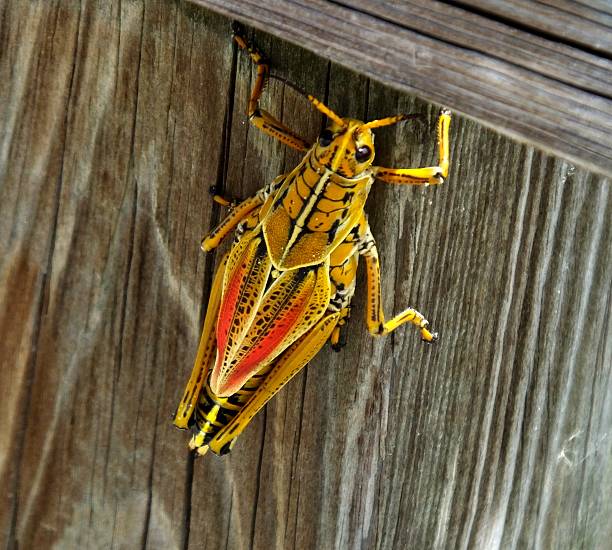
Physical Characteristics & Identification Tips
The Eastern Lubber Grasshopper is one of the largest North American species, often measuring 2 to 4 inches in length. Its body is typically black with bright yellow, red, or orange markings along the wings and legs. Females are larger and heavier than males, making them easily distinguishable. Unlike many grasshoppers, their wings are short, preventing sustained flight but aiding in short hops and glides.
Behavior
This species is slow-moving and primarily diurnal, spending much of its time feeding on vegetation. Its striking coloration acts as a warning to predators, signaling potential toxicity—a behavior known as aposematism. Eastern Lubbers often freeze when threatened, and some may release a pungent chemical to deter predators, making them a memorable encounter for anyone observing them in the wild.
Habitat and Range
Eastern Lubbers are found mainly in the southeastern United States, inhabiting grasslands, roadsides, and open fields. They favor areas with dense vegetation and avoid highly shaded regions. Populations are usually localized, so one might spot them basking in the sun along open fields or garden edges.
Diet
These grasshoppers are herbivorous, feeding on a wide range of plants including crops, wildflowers, and garden vegetation. Their appetite is voracious, yet their impact is often mitigated by their slow movement, which makes them easy prey for natural predators despite their chemical defenses.
Reproduction and Life Cycle
Females lay eggs in soil pods during late summer or early fall. Eggs overwinter and hatch in spring, giving rise to nymphs that gradually develop through several molts. The full life cycle spans one year, with adults emerging in late spring to early summer. Their reproductive strategy relies on producing enough offspring to offset predation losses.
Fun Facts / Unique Traits
The Eastern Lubber’s bright coloration serves as both warning and camouflage among flowers. They are sometimes called “cabbage grasshoppers” because they frequently feed on cabbage and other leafy crops. Fascinatingly, they communicate with subtle body vibrations, a trait rarely observed in grasshoppers of this size.
Human Interaction
Gardeners may occasionally encounter Eastern Lubbers feeding on ornamental plants or crops, but they rarely become major pests due to limited mobility. They are often featured in educational programs, demonstrating aposematic coloration and chemical defense strategies to students and enthusiasts alike.
5. American Bird Grasshopper (Schistocerca americana)
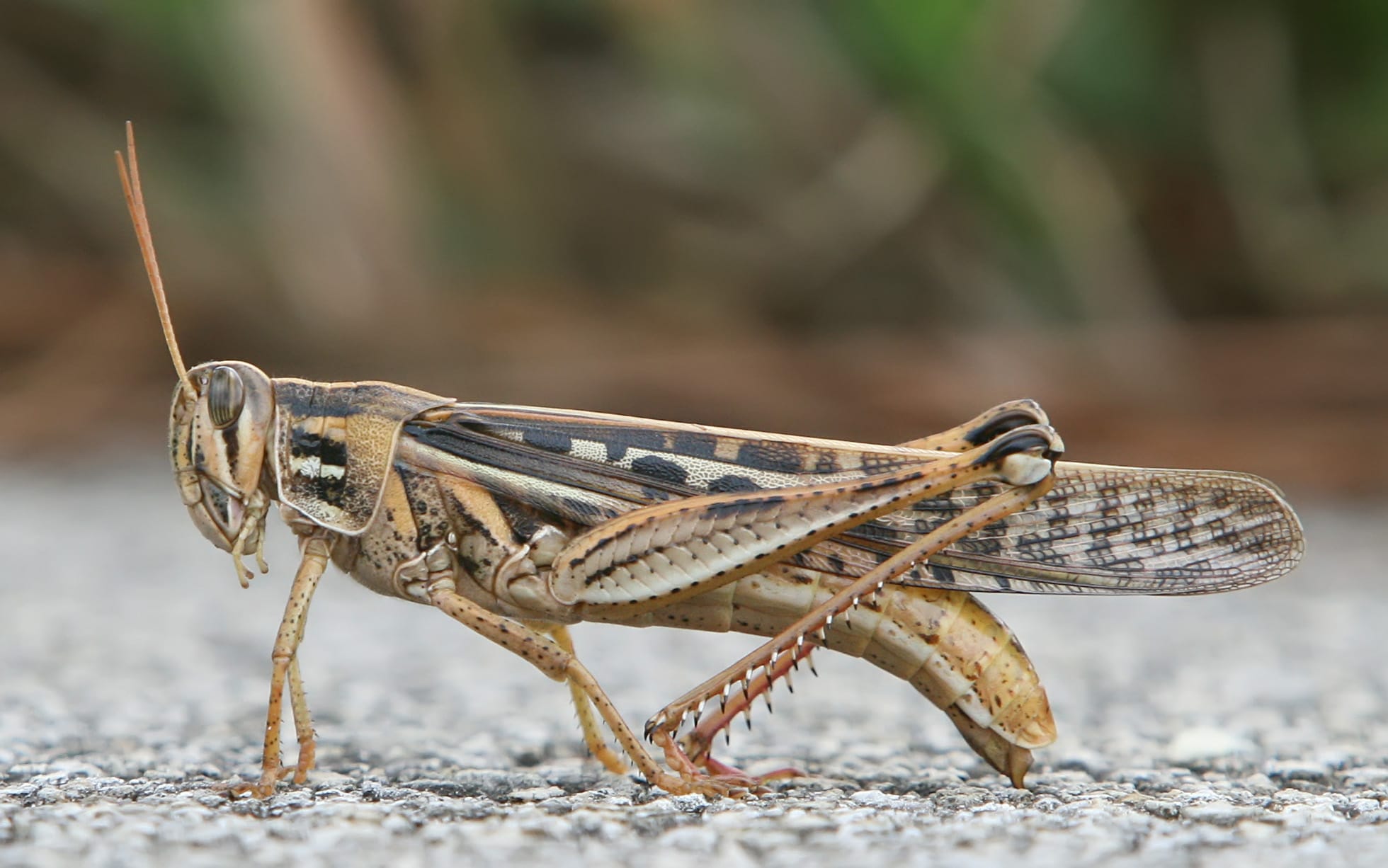
Physical Characteristics & Identification Tips
The American Bird Grasshopper is a robust, medium-to-large species, typically 2 to 3 inches long. Its brown or green body is complemented by strong, elongated hind legs capable of exceptional leaps. The wings are patterned with subtle streaks, aiding in camouflage against grasses. Males are smaller and lighter, while females have a rounded abdomen designed for egg-laying.
Behavior
True to its name, the American Bird Grasshopper is an adept jumper, capable of clearing impressive distances. These grasshoppers are diurnal and are often observed basking in sunlight during early mornings. While generally solitary, they may gather in high densities when food is abundant. Their movements are punctuated by short, fluttering flights that resemble a bird-like glide.
Habitat and Range
American Bird Grasshoppers inhabit much of the southeastern United States, favoring open fields, pastures, and roadside vegetation. They thrive in areas with tall grasses and low shrubs, often blending seamlessly into their surroundings. Observers may notice them on fence posts or tall stems during sunny days.
Diet
This species is herbivorous, feeding on a variety of grasses, forbs, and occasionally cultivated crops. They particularly favor tender green shoots and leaves, consuming significant amounts during peak growth periods. Their selective feeding can influence the composition of local vegetation over time.
Reproduction and Life Cycle
Females deposit eggs in small soil pods, typically laying dozens at a time. Nymphs emerge resembling miniature adults, going through several molts before developing wings and reproductive capability. The life cycle usually spans one year, with adults most visible from late spring through early fall.
Fun Facts / Unique Traits
American Bird Grasshoppers are known for their impressive leaping ability, sometimes clearing distances over 20 times their body length. They are also a key prey species for birds and small mammals, linking grassland plants to higher trophic levels in the ecosystem. Their subtle wing patterns provide effective camouflage, making them difficult to spot when at rest.
Human Interaction
While generally not a severe agricultural pest, large populations can occasionally damage crops and pastures. They provide opportunities for entomology education, allowing students to observe jumping mechanics, feeding behaviors, and ecological interactions in a natural setting.
6. Spur-Throated Grasshopper (Melanoplus sanguinipes)
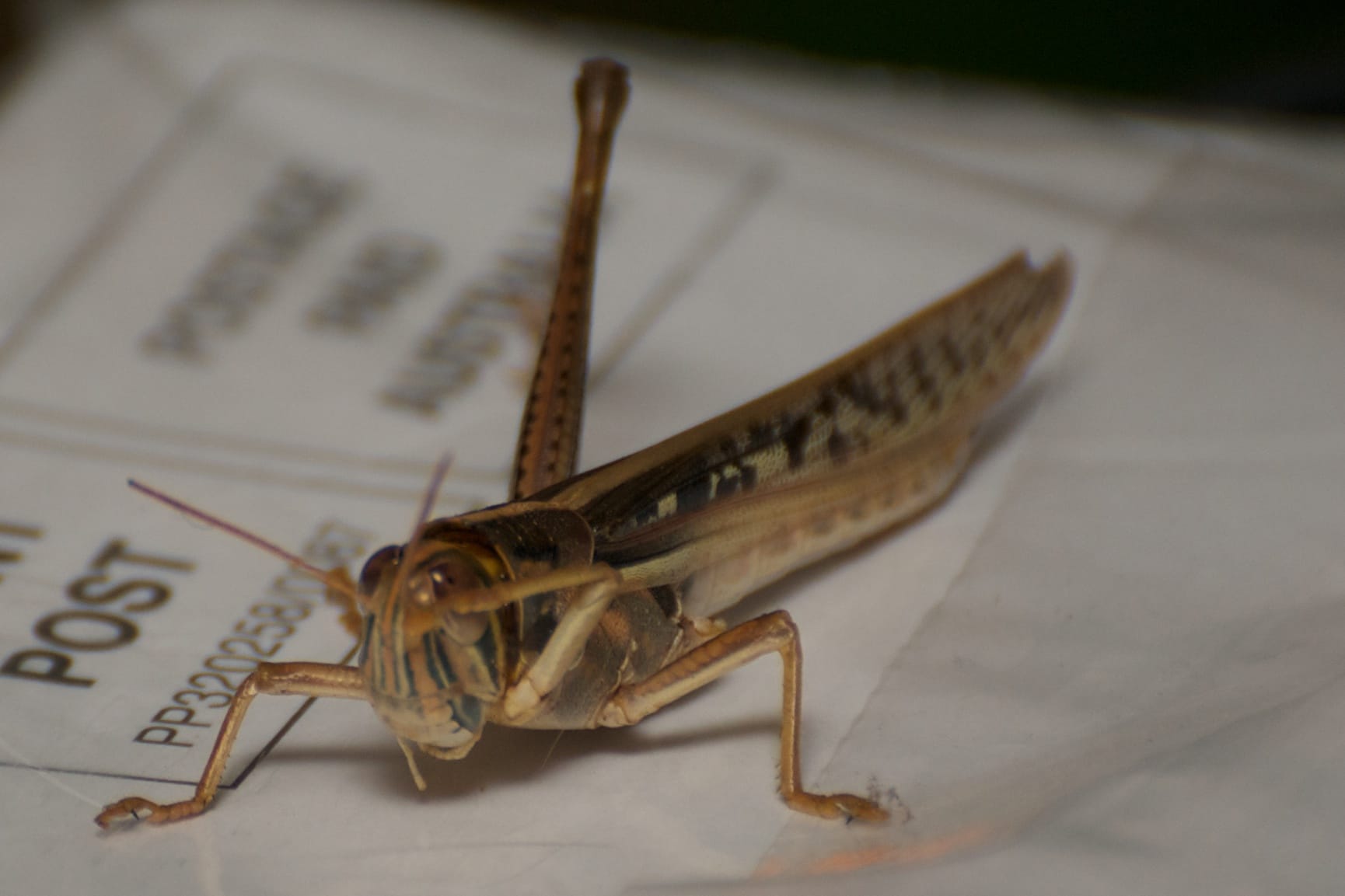
Physical Characteristics & Identification Tips
The Spur-Throated Grasshopper is medium-sized, about 1.25 to 2 inches in length. Its most distinguishing feature is a small spur located between the front legs under the thorax. The body coloration ranges from brown to green, often with faint markings along the sides. Females are larger and more robust than males, and both sexes have strong hind legs built for jumping.
Behavior
This species is active during the day, often seen feeding or leaping across grasses and low vegetation. They are generally solitary but may congregate in favorable feeding areas. Spur-Throated Grasshoppers communicate subtly through leg movements and stridulation, producing faint sounds that are often unnoticed by humans.
Habitat and Range
Spur-Throated Grasshoppers are widespread across North America, thriving in grasslands, prairies, and agricultural fields. They prefer areas with dense grasses and moderate sunlight. They are adaptable and may occasionally be found in suburban gardens or along road verges.
Diet
These grasshoppers feed primarily on grasses and cereal crops but will also consume weeds and broadleaf plants when available. Their feeding can be voracious during peak population periods, occasionally leading to localized damage in pastures or fields.
Reproduction and Life Cycle
Females lay eggs in soil pods, often producing multiple clutches in a single season. Nymphs emerge in spring, resembling miniature adults without wings, and progress through several molts before reaching full maturity. The typical life cycle spans one year, although timing may vary with climate conditions.
Fun Facts / Unique Traits
The spur under the thorax gives this species its name and helps in species identification. They are efficient jumpers and are known to migrate short distances in search of food. Predators include birds, small mammals, and spiders, making them an integral part of the grassland ecosystem.
Human Interaction
Although capable of damaging crops during outbreaks, Spur-Throated Grasshoppers are mostly harmless to humans. Farmers monitor their populations to prevent agricultural losses, while naturalists enjoy observing their jumping behavior and ecological role in maintaining healthy grasslands.
7. Carolina Grasshopper (Dissosteira carolina)

Physical Characteristics & Identification Tips
The Carolina Grasshopper is a large and striking species, measuring 2 to 3 inches in length. Its body is generally brown or gray, providing excellent camouflage among dry grasses. A distinguishing feature is the black hind wings with yellow edges, visible during flight. Females are noticeably larger than males, with a broader abdomen for egg-laying.
Behavior
Carolina Grasshoppers are diurnal and excellent jumpers, able to cover several feet in a single leap. They are solitary by nature but may gather in small groups when feeding areas are abundant. When threatened, they produce a short, buzzing flight sound with their wings—a subtle alarm signal that startles predators.
Habitat and Range
Native to the eastern United States, this species prefers open fields, meadows, and roadside grasses. They are particularly abundant in dry, sandy soils with sparse vegetation. One might observe them resting on tall grasses or basking in sunlight during early mornings.
Diet
Carolina Grasshoppers feed primarily on grasses, herbaceous plants, and occasionally crop seedlings. They are selective feeders, targeting the most tender and nutritious parts of plants, and their feeding can sometimes be noticed in cultivated areas.
Reproduction and Life Cycle
Females lay eggs in soil pods, typically in late summer. Eggs overwinter and hatch the following spring. Nymphs resemble miniature adults but lack wings, gradually molting through several stages before reaching full maturity. The life cycle is typically one year, though timing can vary based on climate.
Fun Facts / Unique Traits
The Carolina Grasshopper’s black-and-yellow wings create a flash of color in flight, startling predators and aiding escape. They are also strong jumpers, sometimes compared to “tiny catapults” in action. Their presence indicates a healthy grassland ecosystem.
Human Interaction
While not considered a serious pest, they may occasionally feed on young crops. Naturalists and educators use them to demonstrate camouflage, jumping mechanics, and grassland ecology to students and enthusiasts.
8. Obscure Bird Grasshopper (Oedaleonotus enigma)
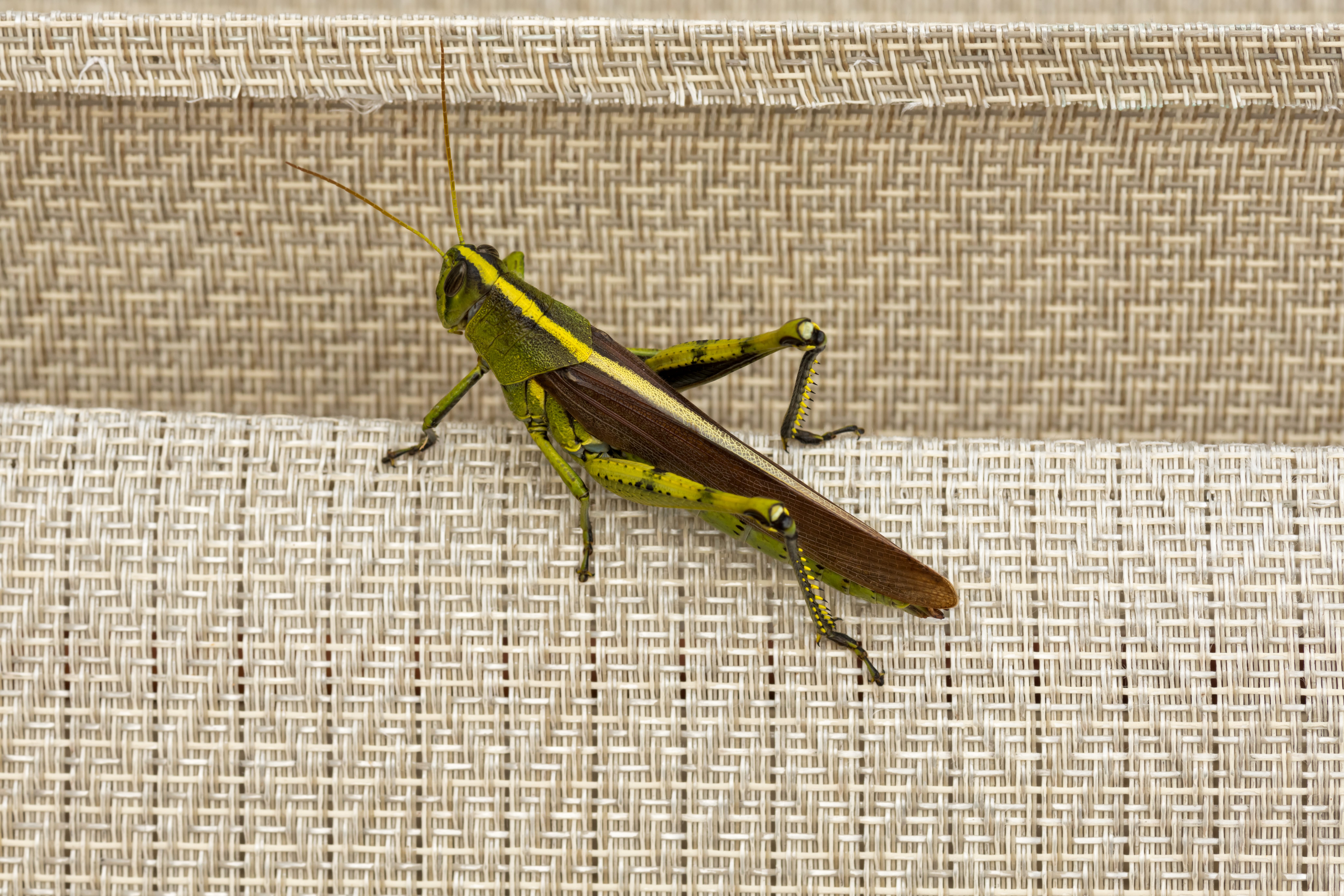
Physical Characteristics & Identification Tips
The Obscure Bird Grasshopper is small to medium-sized, about 1 to 1.5 inches long, with muted brown or gray coloration that allows it to blend seamlessly with dry grasses and soil. Its wings are short and translucent, and males tend to be slimmer than females. The hind legs are strong and spiny, adapted for rapid leaps when escaping threats.
Behavior
This species is mostly solitary and active during daylight hours. It relies on quick, sudden jumps rather than sustained flight to evade predators. Nymphs exhibit the same cautious behavior, moving in short hops between vegetation patches. Observers might find their movement almost imperceptible until a sudden leap occurs.
Habitat and Range
Found primarily in western North America, Obscure Bird Grasshoppers prefer open, grassy plains and semi-arid areas. They are commonly spotted in low vegetation near roadsides or pastures, often blending into the surroundings until startled.
Diet
Their diet consists mainly of grasses, weeds, and forbs. They feed selectively on tender plant parts and are important for controlling vegetation growth naturally. Despite their small size, they consume a notable amount of greenery relative to their body weight.
Reproduction and Life Cycle
Females lay eggs in soil pods, which overwinter until hatching in spring. Nymphs progress through multiple molts before reaching adult size, typically within a single growing season. Adults are most active during warm months, reproducing in mid to late summer.
Fun Facts / Unique Traits
This grasshopper’s subtle coloration and shy behavior make it challenging to observe, hence the “obscure” name. Their sudden leaps can be startling, and they provide food for birds, small mammals, and reptiles, highlighting their role in the food chain.
Human Interaction
Obscure Bird Grasshoppers are generally harmless to humans and crops. They are of interest mainly to entomologists and wildlife observers who study grasshopper diversity and ecology in prairie habitats.
9. Clear-Winged Grasshopper (Camnula pellucida)
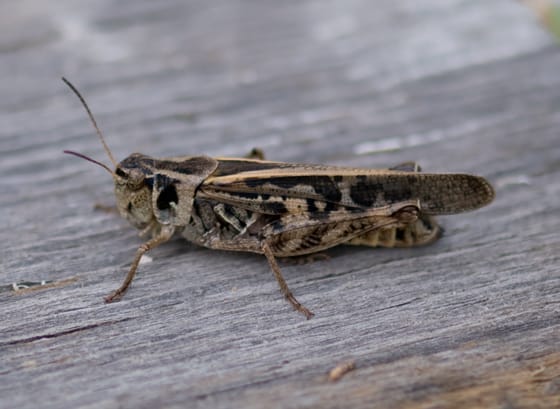
Physical Characteristics & Identification Tips
The Clear-Winged Grasshopper measures about 1.5 to 2 inches long. Its most distinctive feature is the transparent or translucent wings that often reveal underlying veins and patterns. The body is brown or gray, with subtle markings along the back. Females are slightly larger than males, with a more pronounced abdomen.
Behavior
Active during the day, this species is known for both hopping and short flights. Its transparent wings make it less conspicuous during movement. Nymphs are highly active, feeding voraciously and gradually developing wings and reproductive structures through multiple molts.
Habitat and Range
Clear-Winged Grasshoppers are found across North America, especially in open fields, meadows, and agricultural areas. They favor locations with tall grasses or mixed vegetation where they can blend in while feeding and avoiding predators.
Diet
These grasshoppers primarily consume grasses, cereal crops, and other herbaceous plants. They are selective feeders, often targeting tender young shoots. Their feeding behavior contributes to plant community dynamics, occasionally affecting crop yields in high-density populations.
Reproduction and Life Cycle
Eggs are laid in soil pods, with nymphs emerging in spring. The life cycle involves several molts before reaching adult size and reproductive capability. Adults are most active during summer months, with mating occurring shortly after wing development.
Fun Facts / Unique Traits
Transparent wings not only help in camouflage but also reduce the visibility of movement, aiding in predator avoidance. Their sudden leaps and short glides make them agile survivors in open habitats. They also serve as prey for birds, spiders, and small mammals.
Human Interaction
Clear-Winged Grasshoppers generally do not cause significant crop damage, though in large numbers they can feed on pasture grasses. They are valuable for ecological studies, helping researchers understand insect-plant interactions and grassland health.
10. Band-Winged Grasshopper (Oedipodinae – subfamily)
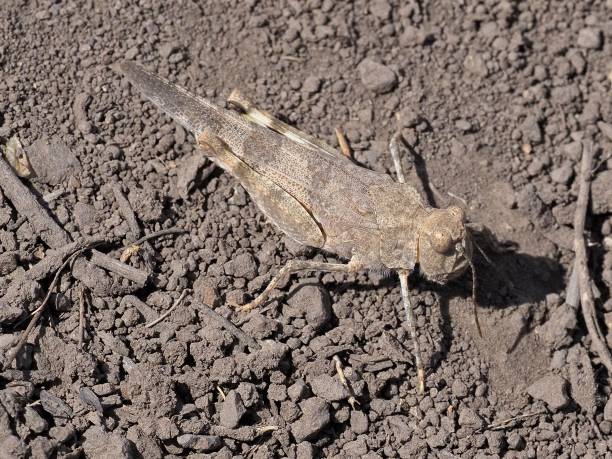
Physical Characteristics & Identification Tips
Band-Winged Grasshoppers are medium-sized, generally 1.5 to 2 inches long. Their most striking feature is the brightly colored hind wings, often red, yellow, or orange, with a contrasting dark band. The forewings are camouflaged in shades of brown or gray, helping them blend seamlessly into sandy or grassy environments. Males are slightly smaller and slimmer, while females are bulkier to accommodate egg-laying.
Behavior
This species is highly active during the day and is an expert jumper. When startled, it produces a sudden flash of its brightly colored wings while leaping, which can confuse predators—a behavior known as deimatic display. Band-Winged Grasshoppers are mostly solitary, though multiple individuals may be found feeding in the same area.
Habitat and Range
Band-Winged Grasshoppers inhabit open plains, grasslands, and dry, sandy areas across North America. They prefer environments with sparse vegetation that allows for easy takeoff during jumps. Their populations often surge in semi-arid regions during warm, dry seasons.
Diet
These grasshoppers feed primarily on grasses and herbaceous plants. They are selective, favoring tender shoots and leaves, which they chew using strong mandibles. Their feeding helps regulate plant growth and contributes to the balance of local grassland ecosystems.
Reproduction and Life Cycle
Females lay eggs in small soil pods, which overwinter and hatch in spring. Nymphs look like miniature adults but lack fully developed wings and must molt several times to reach maturity. The life cycle typically lasts a single year, though environmental conditions can influence development speed.
Fun Facts / Unique Traits
The brightly colored wings are not just beautiful—they serve as a defensive mechanism. When the grasshopper leaps, the sudden flash of color can startle or distract predators. Their hopping is both an escape tactic and an efficient way to move across open terrain.
Human Interaction
While generally harmless, Band-Winged Grasshoppers can occasionally feed on crops and pastures in large numbers. They are excellent subjects for nature observation and classroom studies, providing insights into camouflage, flight mechanics, and grassland ecology.
11. Striped Horse Grasshopper (Hippiscus ocelote)

Physical Characteristics & Identification Tips
The Striped Horse Grasshopper is medium to large, measuring 1.5 to 2 inches. Its most notable feature is the two pale stripes running along its dark brown or olive body. Females are larger with a rounded abdomen for egg-laying, while males are more slender. The hind legs are strong and spiny, adapted for jumping considerable distances.
Behavior
This species is primarily diurnal, hopping and making short flights to evade predators. Nymphs are highly active and feed continuously, growing quickly through multiple molts. Adults produce soft chirping sounds by rubbing their legs against their wings, mainly during mating season, attracting potential mates.
Habitat and Range
Striped Horse Grasshoppers are found throughout North America, preferring open fields, meadows, and pastures. They favor tall grasses for feeding and hiding, and their populations can occasionally concentrate in fertile farmlands. Observers may see them basking in the sun or hopping across grass blades.
Diet
They feed mostly on grasses, cereal crops, and broadleaf plants. Nymphs consume a significant amount of vegetation daily, contributing to the natural pruning of grasslands. Adults continue this pattern, occasionally impacting young crops if numbers are high.
Reproduction and Life Cycle
Eggs are laid in soil pods in late summer. Nymphs hatch the following spring and progress through several molts to adulthood. The full life cycle is typically completed in one growing season, although temperature and food availability can affect development.
Fun Facts / Unique Traits
The dual stripes along the body provide effective camouflage, blending seamlessly with grassy environments. Their jumping ability is impressive, with leaps up to 20 times their body length. They play an essential role as prey for birds, reptiles, and small mammals.
Human Interaction
While not a major pest, large populations can occasionally affect pastures and young crops. They are often used in educational contexts to teach about insect life cycles, camouflage, and grassland ecology. Observing them offers valuable insight into insect behavior and habitat adaptation.
12. Green Grass Pyrgomorph (Atractomorpha lata)

Physical Characteristics & Identification Tips
The Green Grass Pyrgomorph is a medium-sized species, typically 1.25 to 2 inches in length. Its bright green coloration allows it to blend perfectly with grasses and leafy vegetation. The body is elongated and slightly flattened, with short wings that make it more of a hopper than a flyer. Females are larger than males and possess a rounded abdomen for egg-laying.
Behavior
This species is diurnal and slow-moving compared to other grasshoppers, relying on camouflage for protection. They make short hops to move between plants, rarely engaging in long flights. Nymphs are voracious feeders and develop gradually, molting multiple times before reaching adult size.
Habitat and Range
Green Grass Pyrgomorphs are found in tropical and subtropical regions, favoring dense grassy meadows, pastures, and gardens. They thrive in humid environments with abundant foliage. One might spot them hiding among tall grasses, where their green coloration provides near-perfect concealment.
Diet
They feed exclusively on green vegetation, consuming grasses, herbs, and occasionally young crop leaves. Their selective feeding contributes to maintaining healthy plant communities and reducing overgrowth in natural habitats.
Reproduction and Life Cycle
Eggs are deposited in soil pods, typically during the rainy season. Nymphs emerge resembling miniature adults and molt several times before reaching maturity. The full life cycle can vary depending on temperature and humidity, often lasting several months.
Fun Facts / Unique Traits
Their vivid green color provides excellent camouflage, making them difficult to spot even when active. Despite being slow, their sudden hops can surprise predators. They are frequently studied for their feeding habits and ecological role in tropical grasslands.
Human Interaction
Green Grass Pyrgomorphs are generally harmless to humans. In gardens or cultivated areas, they may nibble on plants but rarely cause significant damage. They are valuable for educational purposes, helping students understand insect-plant interactions and the importance of camouflage in nature.
13. Giant Green Slantface (Acrida conica)
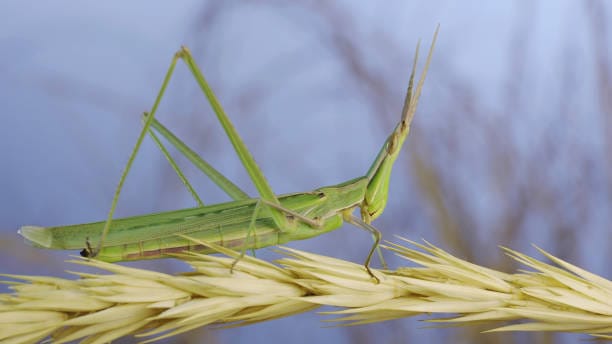
Physical Characteristics & Identification Tips
The Giant Green Slantface is a large, slender grasshopper, typically measuring 2 to 3 inches in length. Its elongated head slopes forward, giving it the characteristic “slantface” appearance. Its body is bright green, blending perfectly with grasses. Females are slightly larger than males, with a rounded abdomen for carrying eggs.
Behavior
These grasshoppers are primarily diurnal and are more inclined to hop than fly. Their movements are deliberate, often stretching out along grass stems to avoid detection by predators. Nymphs mimic adults in appearance but lack fully developed wings, gradually gaining mobility through successive molts.
Habitat and Range
Giant Green Slantfaces are widespread in tropical and subtropical grasslands, savannas, and open fields across Asia and parts of Africa. They prefer areas with dense grassy vegetation that allows both feeding and concealment. Observers may notice them stretching along tall grass stems, almost invisible due to their coloration and posture.
Diet
Their diet consists mainly of grasses and herbaceous plants. They selectively feed on tender shoots and leaves, contributing to natural vegetation control in grasslands. Despite their size, they are efficient herbivores and consume large amounts of plant material relative to their body weight.
Reproduction and Life Cycle
Females lay eggs in the soil or within grass stems, which hatch after a few weeks depending on temperature and humidity. Nymphs undergo several molts before reaching adulthood, with fully developed wings appearing in the final stages. Their life cycle is typically completed in one season in temperate areas, longer in tropical climates.
Fun Facts / Unique Traits
The slanted head is not just a namesake; it allows the grasshopper to feed efficiently on narrow grass stems. Their elongated body and green coloration make them almost invisible in dense grasses, a natural adaptation for predator avoidance. They are often studied for their remarkable camouflage and feeding behavior.
Human Interaction
These grasshoppers are generally harmless to humans, though they may feed on cultivated grasses and crops if present in large numbers. They are valuable for educational and ecological studies, demonstrating the importance of camouflage, feeding strategies, and insect diversity in grassland ecosystems.
14. Egyptian Grasshopper (Anacridium aegyptium)
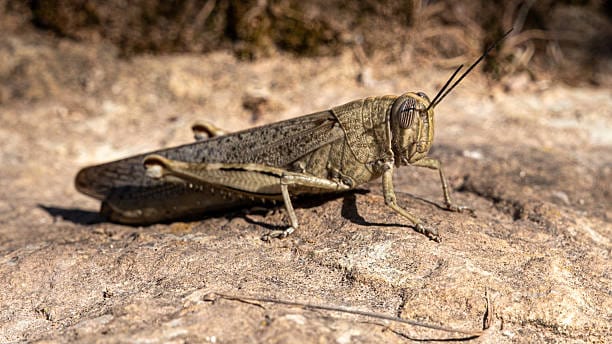
Physical Characteristics & Identification Tips
The Egyptian Grasshopper is a large species, ranging from 2.5 to 4 inches in length. Its body is typically brown or green, with strong hind legs built for powerful jumps. The head is broad, and the wings are long, allowing short flights. Females are bulkier than males and carry numerous eggs in a rounded abdomen.
Behavior
This grasshopper is diurnal and highly mobile. It prefers walking and hopping over flying, but will take short flights when disturbed. Nymphs are very active, feeding continuously and growing through multiple molts. Adults produce faint chirping sounds during mating displays, adding subtle acoustic cues to their behavior.
Habitat and Range
Native to North Africa and parts of Southern Europe, the Egyptian Grasshopper thrives in grasslands, semi-arid areas, and agricultural fields. It prefers open environments with scattered vegetation. Observers may spot them resting on plants or hopping across fields during sunny days.
Diet
They feed primarily on grasses, cereal crops, and broadleaf plants. They are voracious eaters, capable of consuming significant amounts of vegetation, which sometimes brings them into conflict with farmers. Their selective feeding helps regulate plant growth naturally in wild habitats.
Reproduction and Life Cycle
Females lay eggs in soil pods during the warmer months. Nymphs hatch in spring or early summer, resembling adults but lacking wings. They undergo several molts before reaching full maturity. The entire life cycle typically lasts one year, though it can vary depending on environmental conditions.
Fun Facts / Unique Traits
One fascinating trait is their ability to jump extraordinary distances relative to body size, often startling both predators and observers. They are also prey for birds, reptiles, and small mammals, making them an important part of their ecosystem’s food chain.
Human Interaction
Egyptian Grasshoppers occasionally feed on crops in large numbers, making them minor agricultural pests. However, they are often studied for insights into grasshopper biology, locomotion, and ecosystem roles, providing valuable educational and ecological information.
15. Meadow Grasshopper (Chorthippus parallelus)
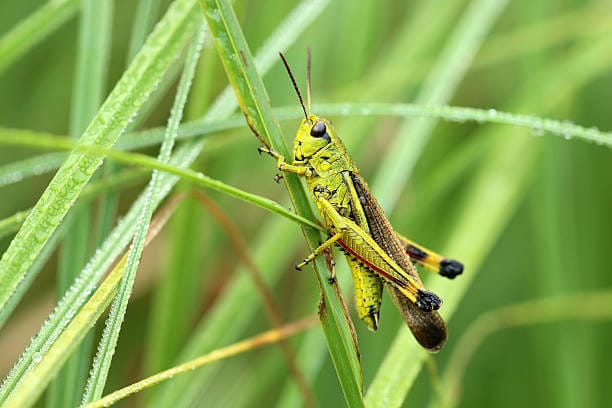
Physical Characteristics & Identification Tips
The Meadow Grasshopper is small to medium-sized, usually 1 to 1.5 inches in length. Its body is green or brown with subtle longitudinal stripes, providing camouflage among grass stems. Females have a rounded abdomen, while males are slimmer and slightly shorter. Hind legs are strong and spiny, ideal for jumping.
Behavior
These grasshoppers are diurnal and highly active. They use jumping as the primary mode of escape and occasionally fly short distances. Nymphs are fast-growing and feed extensively, molting multiple times before reaching adulthood. Adults produce soft, melodic sounds using stridulation to communicate during mating season.
Habitat and Range
Meadow Grasshoppers are widespread across Europe and parts of Asia. They inhabit meadows, pastures, and grassy fields, favoring areas with dense vegetation and moderate sunlight. Their populations thrive in temperate climates and well-maintained grasslands.
Diet
They feed primarily on grasses and herbaceous plants, selectively targeting tender leaves and shoots. Their feeding plays an important role in shaping vegetation structure and supporting ecosystem health. In large numbers, they may influence the composition of meadow plant communities.
Reproduction and Life Cycle
Females lay eggs in soil or grass stems, which hatch in spring. Nymphs undergo several molts before developing wings and reproductive organs. The life cycle is typically completed in one season, with adults most active in late spring and summer.
Fun Facts / Unique Traits
Meadow Grasshoppers are known for their melodic stridulation, which contributes to the gentle background sounds of summer meadows. Their green coloration provides excellent camouflage, allowing them to remain hidden from predators while feeding.
Human Interaction
Generally harmless, Meadow Grasshoppers are important for ecological studies and environmental education. Observing them helps students and enthusiasts understand insect behavior, population dynamics, and the role of grasshoppers in grassland ecosystems.
16. Lesser Marsh Grasshopper (Chorthippus albomarginatus)
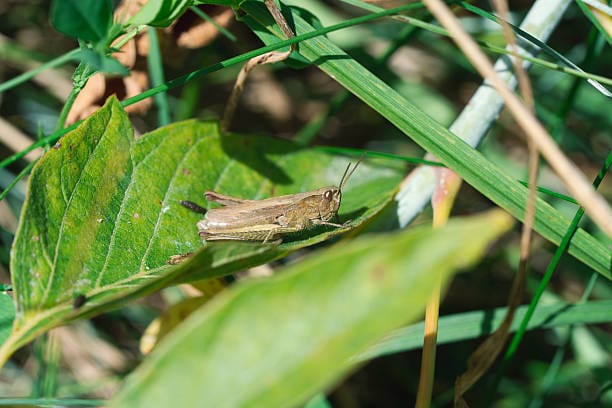
Physical Characteristics & Identification Tips
The Lesser Marsh Grasshopper is small to medium-sized, measuring approximately 1 to 1.5 inches. Its green or brown body features a distinctive pale margin along the hind wings, which helps in identification. Females are slightly larger than males, with a rounded abdomen for egg-laying. Hind legs are well-adapted for leaping long distances.
Behavior
This species is diurnal and prefers hopping over flying, although short flights are possible. Nymphs are active feeders, gradually molting into adult form. Adults are often found resting on grasses, using camouflage and stillness to avoid predators. Their movements are deliberate and often synchronized with surrounding vegetation.
Habitat and Range
Lesser Marsh Grasshoppers inhabit wetlands, marshes, and damp grasslands across Europe and parts of Asia. They prefer moist soils and dense grasses that provide both food and protection. Observers may notice them along marsh edges or in meadows with high humidity.
Diet
The diet consists primarily of grasses and herbaceous plants, including sedges in wetter areas. Their feeding helps regulate vegetation density in marshes and wet meadows. They selectively consume tender shoots and leaves, leaving older, tougher plant material intact.
Reproduction and Life Cycle
Eggs are laid in moist soil or mossy substrates and hatch in spring. Nymphs undergo several molts before reaching adult size and developing wings. The life cycle is typically completed in one year, though wetter conditions can slightly alter timing.
Fun Facts / Unique Traits
The pale hind-wing margin serves as a subtle signal during flight, potentially confusing predators. They are adept jumpers, often using long leaps to escape threats. Their presence indicates healthy wetland ecosystems.
Human Interaction
Lesser Marsh Grasshoppers are harmless to humans and rarely impact agriculture. They are valuable for ecological studies, providing insight into wetland insect populations and the balance of marsh vegetation.
17. Desert Locust (Schistocerca gregaria)
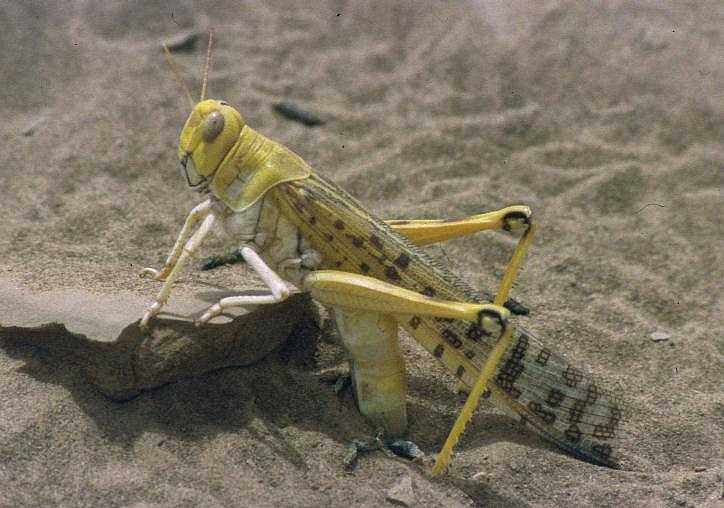
Physical Characteristics & Identification Tips
The Desert Locust is a medium to large species, measuring 1.5 to 3 inches in length. Its coloration ranges from pale yellow to greenish-brown, allowing camouflage in arid environments. The hind wings are typically tinted yellow or pink. Females are bulkier than males, with a larger abdomen for egg production.
Behavior
Desert Locusts are highly mobile and can switch between solitary and gregarious phases depending on population density. In swarming phase, they form massive groups that travel long distances, causing significant ecological and agricultural impacts. Nymphs and adults feed continuously, with short flights or hopping for escape and movement.
Habitat and Range
Native to Africa, the Middle East, and parts of Asia, Desert Locusts inhabit arid and semi-arid regions, including deserts and grasslands. Swarms can migrate thousands of kilometers, following rainfall patterns and vegetation growth. They prefer open areas with sparse to moderate vegetation.
Diet
They are voracious herbivores, feeding on a wide variety of crops, grasses, and wild plants. During swarming phases, their consumption can devastate farmlands, making them infamous in agricultural history. Their strong mandibles allow them to consume large quantities of vegetation rapidly.
Reproduction and Life Cycle
Females lay eggs in moist sand or soil, which hatch within weeks depending on temperature. Nymphs, called hoppers, progress through multiple instars before becoming adults. Swarming behavior develops when populations increase in confined areas, prompting migration and mass reproduction.
Fun Facts / Unique Traits
Desert Locusts are known for their incredible migratory abilities, forming swarms containing millions of individuals. They can fly up to 100 km in a day and are among the most studied species due to their economic impact. Their ability to change behavior and morphology depending on population density is fascinating for entomologists.
Human Interaction
These locusts can cause severe crop losses during outbreaks, threatening food security in affected regions. Governments and scientists monitor and manage populations using ecological and chemical methods. Despite their destructive potential, they are a remarkable example of insect adaptability and swarm behavior.
18. Alpine Grasshopper (Melanoplus alpinus)

Physical Characteristics & Identification Tips
The Alpine Grasshopper is medium-sized, around 1.25 to 1.75 inches long. Its body is typically brown or olive, with subtle striping along the back. Females are slightly larger than males, with a rounded abdomen for egg-laying. The hind legs are strong and spiny, ideal for leaping across rocky alpine terrain.
Behavior
This species is diurnal and well-adapted to cold, high-altitude environments. They are active in sunny periods and often remain motionless during cooler or overcast weather. Nymphs feed actively and molt several times before reaching adult form, with adults showing impressive leaping skills to navigate uneven terrain.
Habitat and Range
Alpine Grasshoppers are found in mountainous regions across Europe and North America, typically above 1,500 meters elevation. They favor open meadows, rocky slopes, and alpine grasslands where vegetation is sparse but adequate for feeding. Observers may spot them basking on rocks or grassy patches.
Diet
They primarily feed on alpine grasses, herbs, and mosses. Their selective grazing helps maintain plant diversity and prevents any one species from dominating fragile alpine ecosystems. They are highly efficient herbivores despite the short growing season at high elevations.
Reproduction and Life Cycle
Eggs are laid in soil or beneath stones and hatch in the short alpine summer. Nymphs grow rapidly through several molts, reaching adulthood in just a few months. The life cycle is adapted to the limited growing season and cooler temperatures, ensuring survival in harsh conditions.
Fun Facts / Unique Traits
The Alpine Grasshopper is adapted to cold climates, able to remain active at lower temperatures than most grasshoppers. Its strong hind legs allow navigation of rocky terrain and sudden jumps to avoid predators. They are a key component of alpine food webs, supporting birds and small mammals.
Human Interaction
Alpine Grasshoppers have minimal impact on humans or agriculture due to their remote habitats. They are studied to understand alpine ecology, climate adaptation, and insect life cycles in high-altitude environments. Observing them provides insight into how insects survive in extreme conditions.
19. Narrow-Winged Sand Grasshopper (Melanoplus angustipennis)

Physical Characteristics & Identification Tips
The Narrow-Winged Sand Grasshopper is medium-sized, usually 1.5 to 2 inches long. Its body is sandy brown or gray, helping it blend into arid soils. As the name suggests, it has narrow wings that limit long flights, making hopping its primary mode of movement. Females are slightly larger than males with a rounded abdomen for egg-laying.
Behavior
This grasshopper is primarily diurnal and relies on camouflage to avoid predators. It makes short hops across sandy patches and uses its muted coloring to remain nearly invisible. Nymphs behave similarly, feeding cautiously and molting several times before reaching adulthood.
Habitat and Range
Narrow-Winged Sand Grasshoppers inhabit dry grasslands, sandy plains, and semi-arid regions across North America. They prefer areas with sparse vegetation where they can easily hide and navigate short distances. Observers may notice them resting motionless on sand or dry soil.
Diet
Their diet consists mainly of grasses and herbaceous plants. They feed selectively on young shoots, avoiding older, tougher vegetation. Their grazing contributes to maintaining the sparse plant cover typical of sandy and semi-arid habitats.
Reproduction and Life Cycle
Females lay eggs in sandy soil pods, which hatch in spring. Nymphs resemble miniature adults but lack wings and must molt several times to reach maturity. The life cycle is typically completed within a single season, adapted to the short growing periods in dry habitats.
Fun Facts / Unique Traits
Their narrow wings limit long-distance flight but make them highly adapted to hopping over sand and low vegetation. Their coloration and behavior provide effective camouflage, helping them avoid predators. They are indicators of healthy semi-arid ecosystems.
Human Interaction
These grasshoppers are generally harmless to humans and crops due to their sparse distribution. They are valuable for ecological studies of arid habitats, demonstrating how insects adapt to sandy soils and limited vegetation.
20. Pasture Grasshopper (Melanoplus confusus)
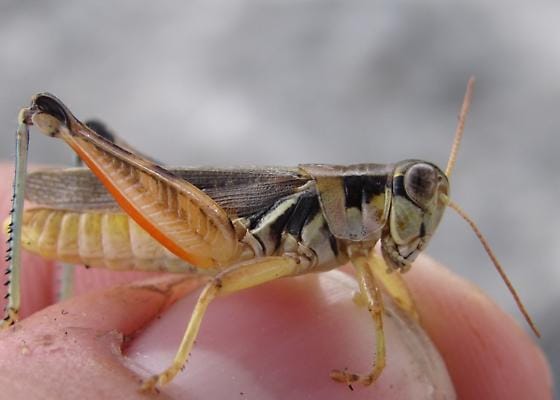
Physical Characteristics & Identification Tips
The Pasture Grasshopper is medium-sized, typically 1.25 to 2 inches in length. Its body is brown or green with subtle markings that blend with grasses. Females are larger and have a rounded abdomen for egg-laying, while males are slimmer. Hind legs are strong and spiny, perfect for jumping across pastures.
Behavior
This species is diurnal and highly active, often hopping and making short flights to escape predators. Nymphs feed continuously and molt several times before reaching adulthood. Adults produce soft sounds during mating season by rubbing their hind legs against wings, known as stridulation.
Habitat and Range
Pasture Grasshoppers inhabit meadows, pastures, and grasslands across North America. They prefer areas with dense grass cover that provides both food and protection. Farmers often notice them hopping between grass clumps on sunny days.
Diet
Their diet primarily consists of grasses and herbaceous plants, occasionally nibbling on crop seedlings in pastures. They play a role in controlling vegetation growth, ensuring plant diversity is maintained. Nymphs are particularly voracious, feeding on tender shoots and leaves.
Reproduction and Life Cycle
Females lay eggs in soil pods during late summer. Nymphs emerge in spring and molt multiple times before developing wings and reproductive capabilities. The life cycle generally lasts one year, with adults most active during summer months.
Fun Facts / Unique Traits
Pasture Grasshoppers are skilled jumpers, capable of leaping 15–20 times their body length. They are important prey for birds, reptiles, and small mammals, linking grassland plants to higher trophic levels. Their subtle coloration makes them difficult to spot among dense grasses.
Human Interaction
Although they occasionally feed on pastures and crops, they rarely reach pest levels. They are valuable in ecological education, helping students understand insect life cycles, grassland ecology, and the balance between herbivores and plant communities.
21. Russianthistle Grasshopper (Aeoloplides turnbulli)
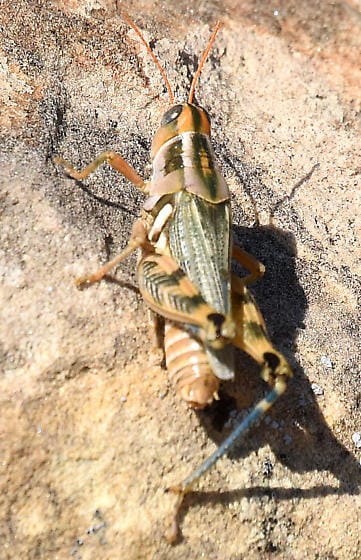
Physical Characteristics & Identification Tips
The Russianthistle Grasshopper is medium-sized, about 1.5 inches long. Its body is pale green or gray with mottled patterns that blend with desert vegetation. Females are slightly larger with a rounded abdomen for eggs. The hind legs are strong for hopping across sandy soils and sparse vegetation.
Behavior
This species is primarily diurnal and relies on short hops to navigate its environment. Nymphs feed constantly and molt several times before adulthood. Adults are often seen basking in the sun, remaining motionless until disturbed, which makes them less noticeable to predators.
Habitat and Range
Russianthistle Grasshoppers are found in arid and semi-arid regions across the western United States and northern Mexico. They favor sandy soils and areas with sparse vegetation, particularly where Russian thistle plants are abundant.
Diet
Their diet primarily includes Russian thistle and other desert plants. They feed selectively on tender shoots and leaves, contributing to vegetation management in desert ecosystems. Their feeding habits help control the growth of invasive plants.
Reproduction and Life Cycle
Eggs are laid in soil pods, typically during summer. Nymphs emerge after several weeks, developing through multiple molts before reaching adult size. The life cycle usually completes within a year, synchronized with warm season plant growth.
Fun Facts / Unique Traits
Their camouflage allows them to remain virtually invisible among desert shrubs. Despite their arid habitat, they are efficient herbivores and contribute to maintaining balance in desert plant communities. Observers may find them surprisingly agile when hopping between sparse vegetation.
Human Interaction
Russianthistle Grasshoppers rarely cause problems for humans or agriculture. They are of ecological interest for studies of desert ecosystems and plant-insect interactions. Watching them provides insight into how insects adapt to harsh, arid environments.
22. Sagebrush Grasshopper (Melanoplus bowditchi)

Physical Characteristics & Identification Tips
The Sagebrush Grasshopper is medium-sized, typically 1.5 to 2 inches long. Its body is predominantly brown or gray with subtle greenish highlights, providing excellent camouflage among sagebrush plants. Females are slightly larger than males, with a rounded abdomen for egg-laying. Hind legs are strong and spiny, ideal for leaping among shrubs.
Behavior
This species is diurnal and primarily relies on hopping to escape predators, occasionally flying short distances. Nymphs are active feeders, molting multiple times before reaching adulthood. Adults often remain still, blending with sagebrush foliage, and may stretch along stems to avoid detection.
Habitat and Range
Sagebrush Grasshoppers inhabit arid and semi-arid regions of North America, particularly areas dominated by sagebrush and desert scrub. They are adapted to open landscapes with sparse vegetation. Observers may notice them resting motionless on sagebrush stems, virtually invisible to predators.
Diet
Their diet primarily consists of sagebrush leaves, grasses, and other desert herbs. They selectively feed on tender shoots, playing a role in managing vegetation and maintaining ecosystem balance. Their presence indicates a healthy sagebrush habitat.
Reproduction and Life Cycle
Females lay eggs in soil pods, which hatch in spring. Nymphs resemble miniature adults and molt several times before developing wings. The life cycle generally completes in one year, aligned with the growth season of sagebrush plants.
Fun Facts / Unique Traits
Their ability to blend seamlessly with sagebrush makes them nearly invisible to predators. Their hopping is highly efficient, allowing quick escape across sparse vegetation. They are an excellent example of adaptation to arid shrubland ecosystems.
Human Interaction
Sagebrush Grasshoppers are harmless to humans and rarely affect crops. They are valuable for ecological studies, helping researchers understand desert and shrubland ecosystems, plant-insect interactions, and camouflage strategies.
23. Devastating Grasshopper (Melanoplus devastator)
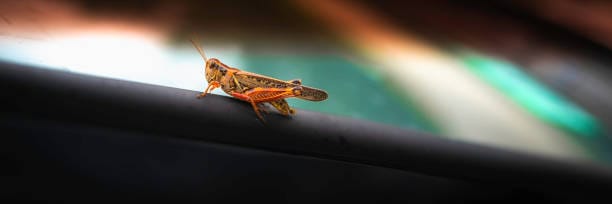
Physical Characteristics & Identification Tips
The Devastating Grasshopper is medium to large, measuring 1.5 to 2.5 inches in length. Its body is brown or gray with faint stripes along the back. Females are larger with rounded abdomens for egg-laying, while males are slimmer. Hind legs are powerful, enabling impressive jumps over grassland vegetation.
Behavior
This species is highly active during the day and uses hopping as the primary mode of movement. Nymphs feed voraciously and molt multiple times before reaching adulthood. Adults occasionally fly short distances but mostly rely on camouflage and stillness to avoid predators.
Habitat and Range
Devastating Grasshoppers inhabit grasslands, prairies, and pastures across North America. They favor areas with dense grasses, which provide both food and concealment. Observers may spot them perched on grass stems or hopping along the ground.
Diet
They feed primarily on grasses and herbaceous plants, occasionally consuming young crop seedlings. Their feeding helps regulate grassland vegetation, although high populations can impact local crops. Nymphs are particularly voracious feeders.
Reproduction and Life Cycle
Females lay eggs in soil pods during late summer. Nymphs hatch in spring and molt several times before developing wings and reproductive organs. The life cycle typically completes in one growing season, with adults most active in warm months.
Fun Facts / Unique Traits
The name “Devastating Grasshopper” hints at their potential impact in large numbers, though they rarely reach swarming levels like locusts. Their powerful hind legs allow them to leap considerable distances, aiding in predator avoidance. They serve as prey for birds, reptiles, and small mammals.
Human Interaction
While generally harmless in small numbers, large populations can feed on crops or pasture grasses. They are studied for insights into grasshopper ecology, behavior, and population dynamics in grassland ecosystems.
24. Bigheaded Grasshopper (Aulocara elliotti)
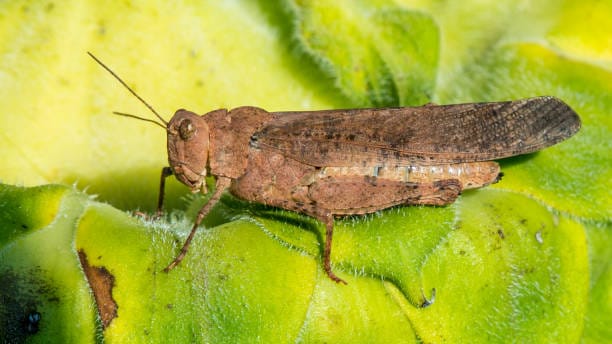
Physical Characteristics & Identification Tips
The Bigheaded Grasshopper is medium-sized, measuring 1.5 to 2 inches long. Its most notable feature is a disproportionately large head compared to its body. The coloration is generally brown or tan with subtle markings that blend with dry grasses. Females are slightly larger with a rounded abdomen, while males are smaller and more streamlined.
Behavior
This species is diurnal and relies on hopping to navigate open grasslands. Nymphs feed continuously and molt several times before adulthood. Adults may remain motionless for long periods, using their large head and camouflaged body to avoid predators.
Habitat and Range
Bigheaded Grasshoppers are found in prairies, grasslands, and open meadows across North America. They favor areas with dense, low vegetation where they can feed and hide effectively. Observers may notice them perched on grass stems, blending seamlessly with their surroundings.
Diet
They feed primarily on grasses and herbaceous plants. Their selective grazing helps regulate grassland vegetation, supporting ecosystem balance. Nymphs are particularly active feeders, consuming tender shoots and leaves.
Reproduction and Life Cycle
Females lay eggs in soil pods, which hatch in spring. Nymphs develop through several molts, gradually acquiring wings and adult characteristics. The life cycle is typically completed within one season, with adults most active in late spring and summer.
Fun Facts / Unique Traits
The enlarged head is not just for show—it houses strong mandibles for efficient feeding. Their camouflage and leaping ability make them adept at avoiding predators. They play a vital role as prey for birds, small mammals, and reptiles in grassland ecosystems.
Human Interaction
Bigheaded Grasshoppers are harmless to humans and rarely affect crops. They are valuable for ecological observation, helping researchers understand grasshopper feeding habits, behavior, and their role in grassland ecosystems.
25. Brownspotted Grasshopper (Psoloessa delicatula)

Physical Characteristics & Identification Tips
The Brownspotted Grasshopper is medium-sized, about 1.5 inches long. Its tan or light brown body features darker brown spots along the wings and abdomen, providing camouflage in dry grasslands. Females are slightly larger with a rounded abdomen for egg-laying, while males are slimmer. Hind legs are strong, allowing efficient hopping.
Behavior
This species is diurnal and primarily uses hopping to move between vegetation. Nymphs feed actively and molt several times before reaching adulthood. Adults often remain motionless to avoid predators, blending seamlessly into their surroundings.
Habitat and Range
Brownspotted Grasshoppers are found across North American prairies, open fields, and dry grasslands. They prefer areas with sparse to moderate vegetation and sandy or loamy soils. Observers may notice them perched on dry grasses or low shrubs, almost invisible due to their spotted pattern.
Diet
They feed primarily on grasses and herbaceous plants. Their grazing contributes to regulating plant growth and maintaining ecological balance in grassland habitats. Nymphs are especially voracious, consuming tender shoots and leaves.
Reproduction and Life Cycle
Females lay eggs in soil pods, typically in late summer. Nymphs hatch in spring and molt multiple times before reaching adulthood. The life cycle usually completes within one growing season, timed to coincide with grass growth.
Fun Facts / Unique Traits
The brown spots provide excellent camouflage, making them difficult to detect even when hopping actively. They are efficient jumpers and important prey for birds, reptiles, and small mammals in grasslands.
Human Interaction
Brownspotted Grasshoppers are harmless to humans and rarely impact agriculture. They are valuable for ecological studies and for teaching about camouflage, insect behavior, and grassland ecosystems.
26. Bruner Slantfaced Grasshopper (Bruneria brunnea)

Physical Characteristics & Identification Tips
The Bruner Slantfaced Grasshopper is medium-sized, about 1.25 to 1.75 inches long. Its brown or tan body is elongated, with a characteristic slanting face. Females are slightly larger with rounded abdomens for egg-laying, while males are slimmer. Hind legs are well-developed for hopping across grasses and shrubs.
Behavior
This species is diurnal, relying on hopping and stillness to avoid predators. Nymphs feed constantly, molting several times before reaching adult form. Adults are often seen stretching along grass stems, using their slanted faces and body orientation for camouflage.
Habitat and Range
Bruner Slantfaced Grasshoppers inhabit prairies, meadows, and open fields across North America. They favor areas with dense grasses and low shrubs, where they can feed and hide effectively. Observers may spot them blending with stems and dry foliage.
Diet
They feed primarily on grasses and herbaceous plants. Their selective feeding helps maintain plant diversity and prevents any one species from dominating. Nymphs are especially active feeders during their development.
Reproduction and Life Cycle
Females lay eggs in soil pods, which hatch in spring. Nymphs undergo several molts before developing wings and reaching maturity. The life cycle typically completes within a single growing season, aligned with grass growth periods.
Fun Facts / Unique Traits
The slant-faced design helps them hide effectively among grass stems. Their hopping is swift and precise, allowing them to escape predators quickly. They are a key part of prairie ecosystems, providing food for birds, reptiles, and small mammals.
Human Interaction
Bruner Slantfaced Grasshoppers are harmless to humans and rarely affect crops. They are frequently studied in ecological research, offering insight into grasshopper behavior, camouflage strategies, and grassland ecosystem dynamics.
27. Clubhorned Grasshopper (Aeropedellus clavatus)
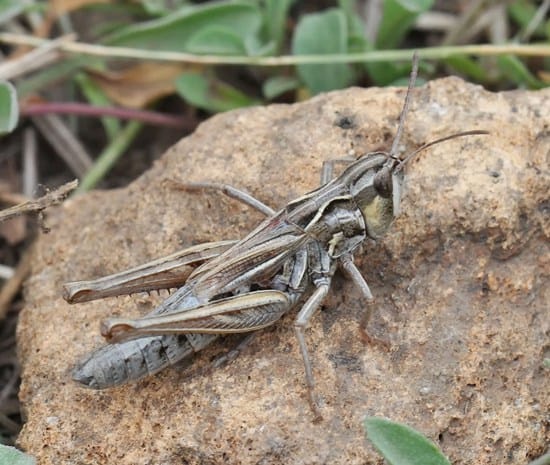
Physical Characteristics & Identification Tips
The Clubhorned Grasshopper is medium-sized, typically 1.5 to 2 inches in length. Its body is brown or gray with subtle patterning, blending well with grasses and shrubs. The most distinctive feature is the small, club-shaped projections on its antennae. Females are larger with rounded abdomens, while males are smaller and more streamlined.
Behavior
This species is diurnal and relies on hopping and camouflage for survival. Nymphs feed actively and molt several times before reaching adult size. Adults often remain still among grass stems or low shrubs to avoid detection.
Habitat and Range
Clubhorned Grasshoppers inhabit prairies, meadows, and mountainous grasslands across North America. They prefer areas with dense grass cover, sandy soils, or rocky terrain, allowing for both feeding and hiding. Observers may spot them perched motionless among grasses.
Diet
Their diet includes grasses, herbs, and occasionally shrubs. Nymphs feed voraciously on tender shoots and leaves, while adults continue selective grazing. Their feeding helps regulate plant growth and contributes to ecosystem balance.
Reproduction and Life Cycle
Females lay eggs in soil pods, which hatch in spring. Nymphs develop through multiple molts before reaching adulthood. The life cycle generally completes within a single growing season, with adults most active during summer months.
Fun Facts / Unique Traits
The club-shaped antennae projections are unique identifiers among grasshoppers. Their camouflage and hopping ability make them effective at avoiding predators. They are an important food source for birds, reptiles, and small mammals in grassland ecosystems.
Human Interaction
Clubhorned Grasshoppers are harmless to humans and rarely impact agriculture. They are studied for ecological research, particularly in grassland habitats, offering insight into insect behavior, adaptation, and plant-insect interactions.
28. Crenulatewinged Grasshopper (Cordillacris crenulata)
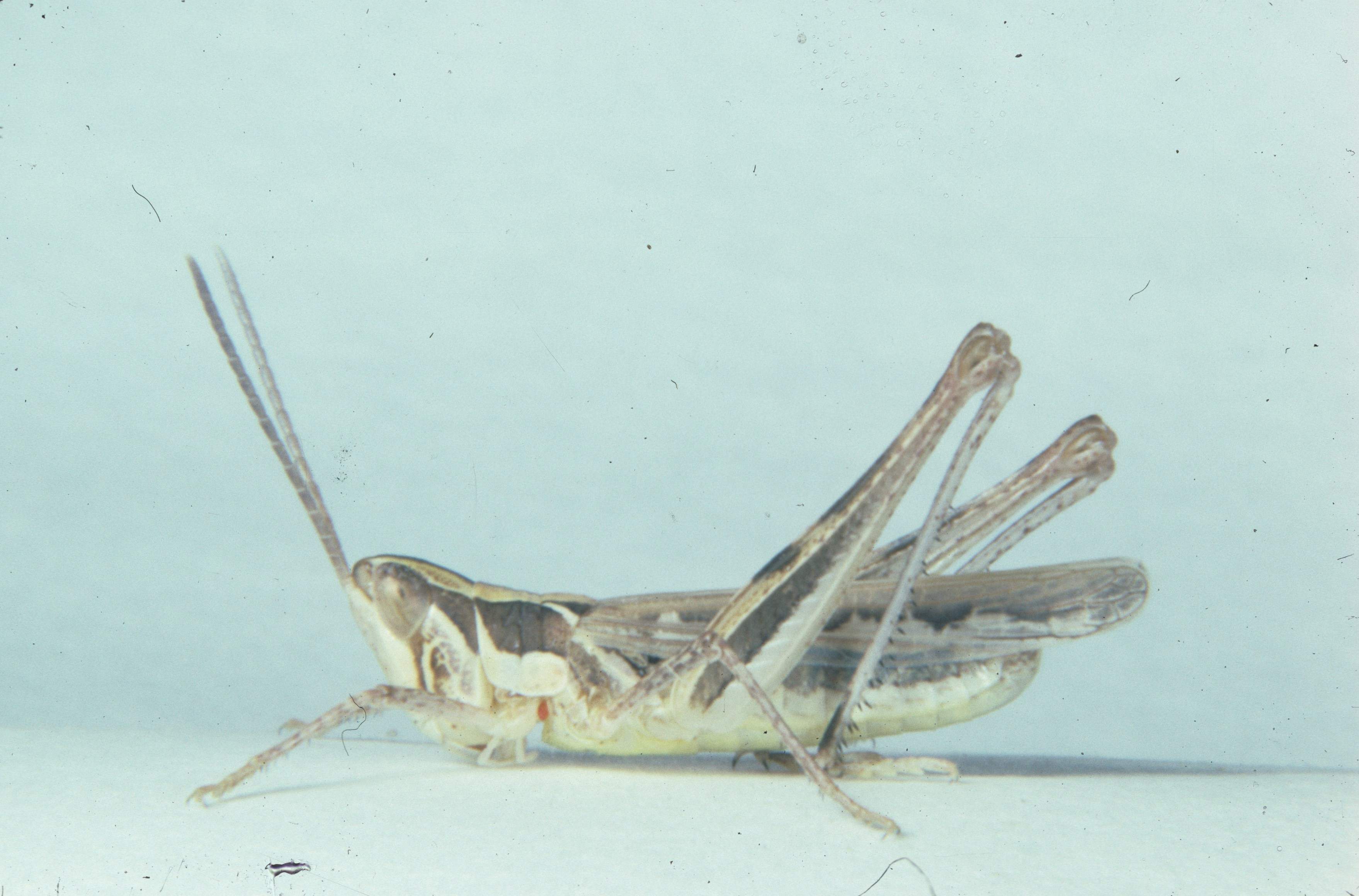
Physical Characteristics & Identification Tips
The Crenulatewinged Grasshopper is medium-sized, typically 1.5 to 2 inches in length. Its body is brown or gray, often with faint striping along the wings and abdomen. The distinctive feature is its crenulated (scalloped) wing edges, which aid in identification. Females are slightly larger with rounded abdomens, while males are smaller and more streamlined.
Behavior
This species is diurnal and relies on hopping for movement, occasionally flying short distances when disturbed. Nymphs feed continuously and molt several times before reaching adult form. Adults often remain still on grass or low shrubs, using their coloration to blend into the environment.
Habitat and Range
Crenulatewinged Grasshoppers inhabit prairies, open meadows, and dry grasslands across North America. They prefer areas with sparse to moderate vegetation and sandy or loamy soils. Observers may notice them resting motionless on grass stems, nearly invisible to predators.
Diet
They feed primarily on grasses and herbaceous plants. Their selective grazing helps maintain plant diversity and balance in grassland ecosystems. Nymphs are particularly voracious, feeding on tender leaves and shoots.
Reproduction and Life Cycle
Females lay eggs in soil pods, which hatch in spring. Nymphs develop through several molts, gradually acquiring wings and adult characteristics. The life cycle typically completes within one growing season, timed with grass growth.
Fun Facts / Unique Traits
The crenulated wing edges are unique identifiers and may aid in camouflage or mating displays. They are efficient jumpers, avoiding predators while blending into grassland vegetation. They are important prey for birds, reptiles, and small mammals.
Human Interaction
Crenulatewinged Grasshoppers are harmless to humans and rarely impact crops. They are valuable for ecological studies, illustrating grasshopper behavior, feeding habits, and adaptation to grassland habitats.
29. Ebony Grasshopper (Boopedon nubilum)
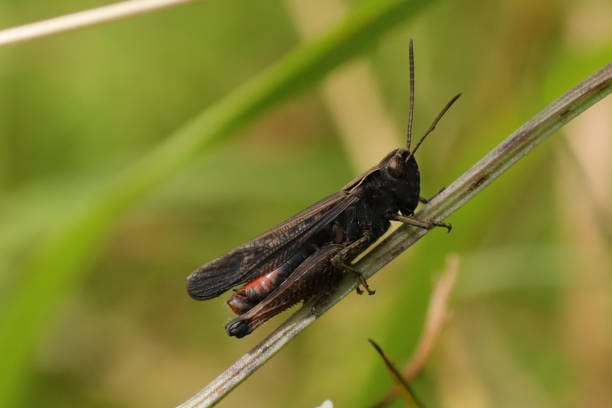
Physical Characteristics & Identification Tips
The Ebony Grasshopper is small to medium-sized, usually 1.25 to 1.75 inches long. Its body is dark brown to black, giving it the “ebony” name. Females are larger with rounded abdomens for egg-laying, while males are slightly smaller. Hind legs are strong and spiny, enabling effective hopping.
Behavior
This species is diurnal and primarily uses hopping to navigate its environment. Nymphs feed continuously and molt multiple times before adulthood. Adults are often motionless on dark or shaded vegetation, using their coloration as camouflage.
Habitat and Range
Ebony Grasshoppers inhabit prairies, open fields, and dry meadows across North America. They prefer areas with sparse to moderate vegetation and soil or plant surfaces where their dark coloration provides effective concealment. Observers may find them resting on shaded plants or ground surfaces.
Diet
They feed primarily on grasses and low-growing herbs. Their grazing helps control vegetation growth and contributes to plant diversity. Nymphs are voracious, consuming young shoots and leaves during development.
Reproduction and Life Cycle
Females lay eggs in soil pods, typically during late summer. Nymphs hatch in spring and molt multiple times before reaching adulthood. The life cycle generally completes within one season, aligned with the growth of grasses and herbs.
Fun Facts / Unique Traits
The dark coloration provides excellent camouflage in shaded areas or among soil and leaf litter. Their hopping ability allows rapid escape from predators. Ebony Grasshoppers are important prey for birds and small mammals, maintaining balance in grassland ecosystems.
Human Interaction
Ebony Grasshoppers are harmless to humans and rarely impact crops. They are often studied for ecological research, providing insight into grasshopper behavior, habitat preference, and camouflage strategies.
30. Four-Spotted Grasshopper (Phlibostroma quadrimaculatum)
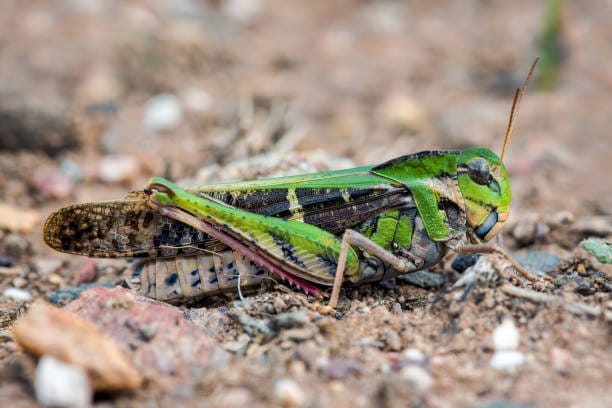
Physical Characteristics & Identification Tips
The Four-Spotted Grasshopper is medium-sized, approximately 1.5 to 2 inches in length. Its tan or light brown body features four distinct dark spots on the wings, which serve as key identification markers. Females are larger with rounded abdomens, while males are smaller and more slender. Hind legs are strong and adapted for jumping.
Behavior
This species is diurnal and primarily relies on hopping to move. Nymphs feed actively and molt several times before reaching adulthood. Adults often remain still on grasses or low vegetation, using their spotted wings as camouflage against predators.
Habitat and Range
Four-Spotted Grasshoppers inhabit dry grasslands, prairies, and open fields across North America. They prefer areas with sparse to moderate vegetation, often resting on grasses that match their body coloration. Observers may spot them blending seamlessly with grass stems and leaves.
Diet
They feed primarily on grasses and herbaceous plants. Nymphs consume tender shoots and leaves, while adults continue selective grazing. Their feeding helps maintain plant diversity and contributes to ecosystem balance.
Reproduction and Life Cycle
Females lay eggs in soil pods, which hatch in spring. Nymphs develop through multiple molts before reaching adult size and acquiring wings. The life cycle typically completes within a single growing season, timed with the availability of fresh grasses.
Fun Facts / Unique Traits
The four dark wing spots are a striking identification feature and may play a role in predator deterrence or mate recognition. Their leaping ability allows rapid escape, and they are important prey for birds, reptiles, and small mammals.
Human Interaction
Four-Spotted Grasshoppers are harmless to humans and rarely affect crops. They are valuable for ecological studies, offering insight into grasshopper behavior, camouflage, and their role in grassland ecosystems.
31. Mottled Grasshopper (Myrmeleotettix maculatus)
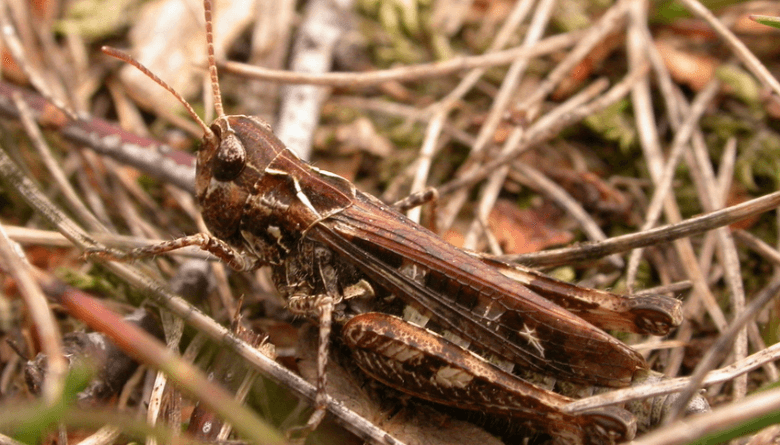
Physical Characteristics & Identification Tips
The Mottled Grasshopper is small to medium-sized, typically 1 to 1.5 inches long. Its body is tan or gray with darker mottled patterns along the back and wings, providing excellent camouflage in dry grasslands. Females are slightly larger than males with a rounded abdomen for egg-laying, while males are slimmer. Hind legs are strong for hopping between grasses.
Behavior
This species is diurnal and relies mainly on hopping for movement. Nymphs feed actively and molt several times before reaching adulthood. Adults often remain motionless, blending into the patterned background of grasses and soil to avoid predators.
Habitat and Range
Mottled Grasshoppers inhabit dry grasslands, meadows, and open fields across Europe and parts of Asia. They prefer areas with sparse to moderate vegetation and sandy or loamy soils. Observers may notice them resting on grass stems or ground surfaces where their mottled coloration provides camouflage.
Diet
Their diet consists primarily of grasses and herbaceous plants. Nymphs consume tender shoots and leaves, while adults continue selective grazing. Their feeding helps regulate plant growth and maintain ecosystem balance in grassland habitats.
Reproduction and Life Cycle
Females lay eggs in soil pods during late summer. Nymphs hatch in spring and molt several times before developing wings and reaching adulthood. The life cycle is typically completed within one growing season, aligned with grass growth periods.
Fun Facts / Unique Traits
Their mottled patterns provide effective camouflage, making them difficult to spot even when hopping actively. They are efficient jumpers and important prey for birds, reptiles, and small mammals in grassland ecosystems.
Human Interaction
Mottled Grasshoppers are harmless to humans and rarely impact agriculture. They are studied in ecological research to understand insect behavior, camouflage, and grassland ecosystem dynamics.
32. Large Marsh Grasshopper (Chorthippus biguttulus)

Physical Characteristics & Identification Tips
The Large Marsh Grasshopper is medium-sized, typically 1.5 to 2 inches long. Its body is green or brown, often with subtle striping along the wings. Females are slightly larger with rounded abdomens for egg-laying, while males are smaller and more streamlined. Hind legs are powerful, ideal for hopping through dense marsh vegetation.
Behavior
This species is diurnal and uses hopping as the primary mode of movement, though short flights are possible. Nymphs feed actively and molt multiple times before reaching adulthood. Adults often perch on grasses or reeds, remaining motionless to avoid predators.
Habitat and Range
Large Marsh Grasshoppers inhabit wetlands, marshes, and damp grasslands across Europe and parts of Asia. They prefer areas with dense vegetation, particularly near water bodies. Observers may find them perched on reeds or tall grasses, blending into their surroundings.
Diet
They feed primarily on grasses, sedges, and herbaceous plants in wetland habitats. Their grazing helps maintain the balance of marsh ecosystems by preventing any single plant species from dominating. Nymphs are particularly voracious feeders.
Reproduction and Life Cycle
Females lay eggs in moist soil or sediment. Nymphs hatch in spring, molting several times before reaching adult size. The life cycle is completed within one season, synchronized with the growth of marsh vegetation.
Fun Facts / Unique Traits
The Large Marsh Grasshopper is well-adapted to wet habitats and can often be seen hopping along reeds without making noticeable noise. Their presence indicates healthy marsh ecosystems, and they are key prey for birds, amphibians, and small mammals.
Human Interaction
These grasshoppers are harmless to humans and have minimal impact on agriculture. They are important for ecological studies, helping researchers understand wetland insect populations and the role of herbivores in marsh ecosystems.
33. Giant Red-Winged Grasshopper (Tropidacris cristata)
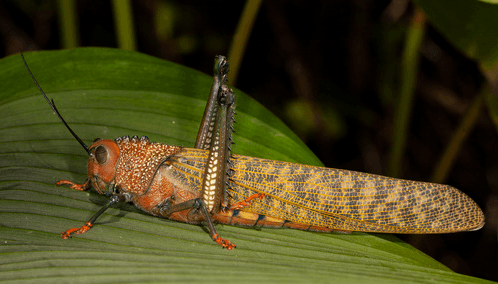
Physical Characteristics & Identification Tips
The Giant Red-Winged Grasshopper is one of the largest grasshoppers in the world, measuring 4 to 6 inches in length. Its body is green with striking red hind wings, easily visible during flight. Females are larger and heavier than males, with robust abdomens for egg-laying. Strong hind legs allow for powerful jumps, despite their large size.
Behavior
This species is diurnal and capable of both hopping and strong flight. Nymphs feed actively and molt multiple times before reaching adulthood. Adults are capable of long-distance flights when disturbed, making them both impressive and elusive.
Habitat and Range
Giant Red-Winged Grasshoppers are found in tropical forests and grasslands across Central and South America. They prefer areas with dense vegetation where they can feed and hide effectively. Observers may notice them perched on plants or flying between tree branches.
Diet
They feed on leaves, grasses, and various herbaceous plants. Their strong mandibles allow them to consume large amounts of foliage, sometimes defoliating small shrubs or young trees. Nymphs feed continuously, contributing to rapid growth.
Reproduction and Life Cycle
Females lay eggs in soil or leaf litter. Nymphs hatch and undergo multiple molts before becoming adults. The life cycle is annual, with adults most active during the wet season when vegetation is abundant.
Fun Facts / Unique Traits
Their enormous size and vivid red wings make them one of the most visually striking grasshopper species. Despite their size, they are agile jumpers and capable fliers. They are a fascinating subject for entomologists due to their size, coloration, and behavior.
Human Interaction
While generally harmless to humans, large populations can damage crops or young trees. They are studied for insights into tropical insect ecology, large herbivore behavior, and ecosystem interactions in forested habitats.
34. Short-Horned Grasshopper (Caelifera)

Physical Characteristics & Identification Tips
The Short-Horned Grasshopper belongs to the suborder Caelifera and varies widely in size, typically 1 to 2 inches long. Its most notable feature is short, stubby antennae compared to long-horned species. Body coloration ranges from green to brown, often with subtle striping. Females are slightly larger with rounded abdomens, while males are smaller and more agile.
Behavior
Short-Horned Grasshoppers are diurnal and rely primarily on hopping, with short bursts of flight when needed. Nymphs feed actively and molt several times before reaching adulthood. Adults often remain still, camouflaging with grasses or soil to avoid predators.
Habitat and Range
They inhabit grasslands, meadows, prairies, and open fields worldwide. They prefer areas with moderate to sparse vegetation and often perch on grass stems or low shrubs. Observers may spot them blending seamlessly with their surroundings.
Diet
They feed mainly on grasses and herbaceous plants, with nymphs consuming young shoots and leaves. Adults maintain selective grazing, contributing to plant diversity and ecosystem balance.
Reproduction and Life Cycle
Females lay eggs in soil pods, which hatch in spring. Nymphs molt multiple times before developing wings and reaching maturity. The life cycle is generally completed within one season, timed to coincide with grass growth.
Fun Facts / Unique Traits
Short-Horned Grasshoppers are named for their brief antennae, which distinguish them from long-horned relatives. Despite their size, they are agile jumpers and a vital food source for birds, reptiles, and small mammals.
Human Interaction
These grasshoppers are harmless to humans and rarely impact crops. They are valuable for ecological research, providing insight into grasshopper behavior, adaptation, and their role in grassland ecosystems.
35. Long-Legged Grasshopper (Pardalophora apiculata)

Physical Characteristics & Identification Tips
The Long-Legged Grasshopper is medium to large-sized, typically 1.5 to 2.5 inches long. Its most distinctive feature is elongated hind legs, adapted for powerful jumps. Body coloration is generally tan or brown, sometimes with subtle stripes. Females are slightly larger with rounded abdomens for egg-laying, while males are more streamlined.
Behavior
This species is diurnal and relies on hopping and occasional short flights. Nymphs feed actively, molting multiple times before reaching adulthood. Adults can remain motionless among grasses or low shrubs to avoid predators.
Habitat and Range
Long-Legged Grasshoppers inhabit grasslands, open fields, and prairies across North America. They prefer areas with dense grass cover for feeding and protection. Observers may notice them perched on grass stems, blending with their surroundings.
Diet
They feed primarily on grasses and herbaceous plants. Nymphs are voracious feeders, consuming young shoots, while adults feed selectively. Their grazing helps regulate vegetation and maintain ecosystem balance.
Reproduction and Life Cycle
Females lay eggs in soil pods, which hatch in spring. Nymphs undergo several molts before reaching adult size and developing wings. The life cycle typically completes within one season, timed with grass growth.
Fun Facts / Unique Traits
The elongated hind legs allow extraordinary jumping ability, making them adept at escaping predators. They play a critical role in grassland food webs, serving as prey for birds, reptiles, and small mammals.
Human Interaction
Long-Legged Grasshoppers are harmless to humans and rarely affect crops. They are studied for ecological insights into grasshopper behavior, feeding habits, and their role in grassland ecosystems.
Conclusion
Grasshoppers are fascinating and diverse insects, ranging from the tiny Mottled Grasshopper to the impressive Giant Red-Winged Grasshopper. Each species has unique adaptations, from camouflaging patterns to powerful jumping legs, allowing them to thrive in a variety of habitats around the world. They play a vital role in ecosystems, serving as herbivores that regulate plant growth and as prey for birds, reptiles, and small mammals.
Understanding the Types of Grasshoppers not only helps us appreciate the complexity of insect life but also highlights their importance in maintaining healthy ecosystems. Observing these grasshoppers in their natural habitats can reveal their fascinating behaviors, from hopping and stridulating to mating and feeding. Even the most common species, like the Pasture Grasshopper, have remarkable traits worth noticing.
Next time you spot a grasshopper hopping across a meadow or blending into the grasses, take a moment to appreciate its role in nature. Whether you are an entomology enthusiast, a student, or just a curious observer, learning about these insects adds depth to your understanding of the natural world and the intricate connections within it.
From their distinctive appearances to their ecological importance, grasshoppers truly exemplify the richness and diversity of insect life, making them one of nature’s most interesting and valuable creatures.
Frequently Asked Questions About Grasshoppers
1. What are grasshoppers?
Grasshoppers are insects belonging to the order Orthoptera, known for their powerful hind legs that allow them to jump long distances. They are primarily herbivorous and are found in diverse habitats worldwide.
2. How many types of grasshoppers are there?
There are thousands of grasshopper species globally. This article focuses on 35 of the most notable species, ranging from the tiny Mottled Grasshopper to the Giant Red-Winged Grasshopper.
3. What is the difference between short-horned and long-horned grasshoppers?
Short-horned grasshoppers have short, stubby antennae and belong to the suborder Caelifera, while long-horned grasshoppers have long, thread-like antennae and belong to the suborder Ensifera.
4. What do grasshoppers eat?
Grasshoppers primarily feed on grasses, leaves, and herbaceous plants. Some species may eat shrubs or crops, depending on their habitat and size.
5. Where do grasshoppers live?
Grasshoppers live in a variety of habitats, including grasslands, meadows, marshes, deserts, and tropical forests. Each species has specific preferences for vegetation and climate.
6. Are grasshoppers harmful to humans?
Grasshoppers are harmless to humans. They do not bite or sting, though large populations can sometimes impact crops.
7. How do grasshoppers reproduce?
Females lay eggs in soil pods or plant material. Nymphs hatch and undergo several molts before reaching adult size and developing wings.
8. How long do grasshoppers live?
The lifespan of a grasshopper depends on the species but usually ranges from a few months to a year. Most complete their life cycle within a single growing season.
9. Can grasshoppers fly?
Yes, most adult grasshoppers can fly short to moderate distances. Some larger species, like the Giant Red-Winged Grasshopper, are capable of longer flights.
10. Why do grasshoppers jump?
Grasshoppers use their powerful hind legs to jump as a primary mode of locomotion and to escape predators quickly.
11. Are grasshoppers considered pests?
Some species can be agricultural pests when their populations are high, feeding on crops and grasses. However, most species play an important ecological role in their habitats.
12. What predators eat grasshoppers?
Grasshoppers are preyed upon by birds, reptiles, small mammals, amphibians, and even other insects.
13. How can I identify a grasshopper species?
Identification is based on features such as body size, coloration, wing shape, antennae length, leg size, and habitat. Many species have distinctive markings, like the Four-Spotted Grasshopper or the Crenulatewinged Grasshopper.
14. Are grasshoppers beneficial for the environment?
Yes, they help regulate plant growth, serve as prey for wildlife, and contribute to nutrient cycling in ecosystems.
15. What is the difference between a grasshopper and a locust?
Locusts are a type of grasshopper that can swarm in large numbers under certain environmental conditions, causing significant crop damage. Not all grasshoppers exhibit this behavior.
16. How do grasshoppers communicate?
Grasshoppers communicate primarily through stridulation, which involves rubbing their legs against wings or body surfaces to produce sounds, especially during mating rituals.
17. Can grasshoppers survive winter?
Grasshoppers survive winter in the egg stage, which remains dormant in the soil until spring, when the nymphs hatch.
18. Are grasshoppers nocturnal or diurnal?
Most grasshoppers are diurnal, meaning they are active during the day. Some species may feed in the early morning or late afternoon.
19. How big can grasshoppers get?
Sizes vary greatly by species. The Mottled Grasshopper may be just 1 inch long, while the Giant Red-Winged Grasshopper can reach 6 inches.
20. Do grasshoppers make sounds?
Yes, many grasshoppers produce sounds by rubbing their hind legs against their wings or abdomen. These sounds are used to attract mates or establish territory.
21. Can grasshoppers swim?
Grasshoppers are not adapted for swimming but can survive brief encounters with water or drop into shallow puddles without drowning.
22. How fast can grasshoppers jump?
Grasshoppers can jump distances many times their body length, often exceeding 20–30 times their size, depending on the species and leg strength.
23. What colors do grasshoppers come in?
Grasshoppers exhibit a range of colors from green and brown to gray, tan, and even bright shades like red or orange on wings, depending on the species.
24. Are grasshoppers social insects?
Most grasshoppers are solitary, though some species, particularly locusts, can form large aggregations or swarms under certain conditions.
25. How do grasshoppers avoid predators?
They use camouflage, rapid hopping, short bursts of flight, and sometimes warning coloration to escape predators.
26. Can grasshoppers bite humans?
Grasshoppers have mandibles for chewing plants but generally do not bite humans. They may nibble if handled, but this is harmless.
27. How do grasshoppers contribute to science?
Grasshoppers are studied for ecology, behavior, physiology, and population dynamics. They provide insight into insect adaptation and ecosystem health.
28. Do grasshoppers migrate?
Most grasshoppers stay localized, but certain species like the Desert Locust can migrate long distances in search of food.
29. Can I keep a grasshopper as a pet?
Yes, some small species can be kept temporarily in terrariums for observation, but they are best appreciated in the wild for ecological reasons.
30. How do grasshoppers impact agriculture?
In large numbers, grasshoppers can damage crops by feeding on leaves and stems. However, most species have minimal impact on human agriculture.
31. How do grasshoppers breathe?
Grasshoppers breathe through a system of spiracles and tracheae, which deliver oxygen directly to their tissues without lungs.
32. Can grasshoppers live in deserts?
Yes, many species, like the Desert Locust or Sagebrush Grasshopper, are adapted to arid environments and can survive extreme temperatures.
33. How do nymphs differ from adult grasshoppers?
Nymphs resemble miniature adults but lack fully developed wings and reproductive organs. They molt several times before reaching adult form.
34. Are grasshoppers endangered?
Most grasshopper species are not endangered, though habitat loss and environmental changes can threaten some localized populations.
35. What is the largest grasshopper species?
The Giant Red-Winged Grasshopper (Tropidacris cristata) is among the largest, reaching up to 6 inches in length and displaying vibrant red wings during flight.
Read more: 35 Types of Antelope (Pictures and Identification)
